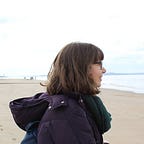#72: The Library Bag
For how long will I be able to fill my bag from public libraries?
I have always had a library bag. As a child, I had a book bag for school: a blue scratty thing, with fluffy velcro incapable of holding much more than a piece of homework. Trips to the library, however, required a sturdier affair, with depth enough for ten books, determined velcro, and even a pocket for my library card. It got a lot of use. Now, I have progressed to a rucksack, but even then, it is never enough. Precariously perched on my shoulder I have an overflow bag, a tote like the one above, misshapen by the books it holds, unbalancing my purposeful ‘to-the-library!’ stride.
Libraries come in as many varieties as the books they hold — private lending libraries, university libraries, national libraries, museum libraries, private collections — but the type of library I tottered out of most as a child, dragging my bag of books, was the local public library.
This library bag speaks a simple truth:
If you are going to get anywhere in life, you have to read a lot of books. — Roald Dahl
Libraries originally ran as private, subscription based services — think Netflix with physical books — but the Public Libraries Act in 1850 marked the beginnings of a free library service in Britain. The aim of this act is echoed in Roald Dahl’s words: increasing access to reading material for the improvement of the public. Providing free access to knowledge, fostering a love of reading, and creating a public social place, libraries are about opportunity, equality, and education.
But public libraries are struggling. The number of council-run libraries in the UK decreased from 4,290 to 3,765 between 2010 and 2015; they are more and more reliant on volunteers than paid staff; budgets everywhere are being cut. This all seems completely counter-intuitive in view of the Society of Chief Librarian’s statement that there are more library visits per year in the UK than visits to football matches, A&E, Church, and the cinema combined. According to the SCL there are, in fact, 8.4 library visits per second.
In the Easter holidays I crammed my laptop, a pile of books, and a packed lunch into my backpack, and tackled my essays in a public library. My nearest library, sadly, could not provide the services I required — merely a table to work on — so I was forced to haul everything to the station and onto a train every morning. If these services are to survive, they need to adapt to the needs of the public, including elements — eating spaces, work spaces, WiFi — that already exist in many university libraries, but are lacking in the public sphere.
The library I did go to was always busy, and always full of the widest variety of people: newspaper readers, CV writers, revisers, map studiers, family history researchers, and, I decided as I studied the work habits of those around me, perhaps even a novel writer. The diversity of people there was incredible, all brought together by a service aimed at helping people learn and use that knowledge in their own unique manner: to pass a test, to start a conversation, to get a job.
Perhaps the only way to ensure these services survive is to use them faithfully and frequently. My Grandad was the first person to borrow a book from our local library, and I will continue the tradition, carrying my bag to as many libraries as possible and heaving it, overfilled, home. I only hope libraries survive long enough for me to do so.
